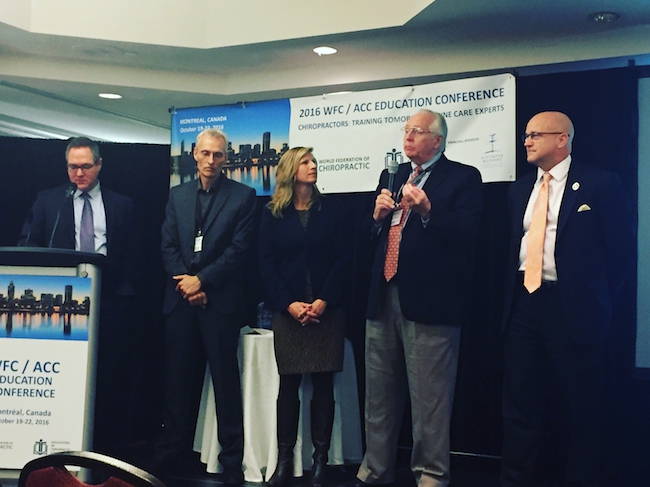
Chiropractic educators discuss future of profession at Montreal conference
Mari-Len De
Features Education Profession Panel on Present and Future Perspectives on Chiropractic Education: (L-R) Dr. Christoper Cassirer, Dr. Henrik Lauridsen, Dr. Michele Maiers, Dr. Gerard Clum, Dr. William Morgan
Panel on Present and Future Perspectives on Chiropractic Education: (L-R) Dr. Christoper Cassirer, Dr. Henrik Lauridsen, Dr. Michele Maiers, Dr. Gerard Clum, Dr. William Morgan MONTREAL – Advocating for chiropractic to be “separate and distinct” does not mean chiropractors will be “isolated and alone.” This was the argument put forth by Dr. Gerard Clum during a panel session at this week’s education conference in this city, hosted jointly by the World Federation of Chiropractic (WFC) and the Association of Chiropractic Colleges (ACC).
Clum stressed he supports the push for chiropractic integration in interprofessional health care, but believes it should happen while maintaining the chiropractic identity.
“If there is no distinction to what you do, then you have no ability to define what you bring to the marketplace,” Clum explained.
He noted other health care disciplines are already increasingly intent on being able to provide spinal health care, potentially threatening the distinct value proposition of chiropractors.
“Other disciplines would like to do what we do,” Clum pointed out. “We proved the value in the marketplace, now they want to do what we do. But they’re not interested in chiropractic; they just want to do what we do”
While many agree that spinal health is not the only area of health care chiropractors can excel, it is where chiropractors are gaining ground, said Dr. William Morgan, president of Parker University.
Morgan, who also spoke at the conference panel, is a former chiropractor to the U.S. Capitol and clinician at Walter Reed National Military Centre. He spoke about his experiences working as a spine care expert in an interprofessional health care team.
He said by being active in a hospital setting – with access to more resources – chiropractors can demonstrate the benefits of conservative, non-drug patient care.
“If we try chiropractic before epidural injections, we would save billions of dollars,” Morgan noted, who also worked as White House chiropractor and team chiropractor for the United States Naval Academy football team.
Morgan outlined many of the benefits for chiropractors working as a team player in a hospital environment, such as having access to a big database of patient history and records allowing for better interprofessional collaboration, and the ability to “learn things that we would not have even researched as chiropractors.”
He maintained chiropractic should capitalize on its value proposition as musculoskeletal health experts to gain more ground in the integrated health care system.
Chiropractic’s strength is in “musculoskeletal pain, wellness and athletic enhancement,” he said. “We’ve made the breakthroughs and we should exploit them.”
Interprofessional education is also important in shaping new generations of chiropractors. In his presentation, Dr. Henrik Hein Lauridsen, head of chiropractic at University of Southern Denmark, outlined the curriculum for chiropractic students at his university, which is integrated at some level with medical students.
Lauridsen suggested some elements important for developing interprofessional education for chiropractic students.
“When we design the curriculum, make it congruent with university-based education,” he recommended. “Focus chiropractic education on evidence, critical thinking, team work and best practices.”
It’s also important, he added, that the “type of education you develop is actually aligned with how the actual health care system works.”
Northwestern Health Sciences University’s Dr. Michele Maiers was also on the panel and spoke about developing future generations of chiropractors who are innovators.
She said that while chiropractic students currently graduate with adequate clinical skills, oftentimes they do not have sufficient skills to be leaders in health care.
The chiropractic education system should enable its students to think and “act outside the box.”
“As expectations go beyond competent clinical care… our educational institutions need to prepare (students) for the changing demands of health care,” said Maiers, who is the executive director of innovations and research at Northwestern.
Maiers said education for the next generations of chiropractors should focus on: communication skills, professional engagement, fostering a spirit of innovation and contemporary leadership.
Chiropractic educators, she added, should “serve as advocates to champion our students to be the next leaders in health care.”
More than 160 chiropractors, educators, researchers and students are in attendance at the WFC/ACC Education Conference, being held in this city from Oct. 29 to 22.
Print this page